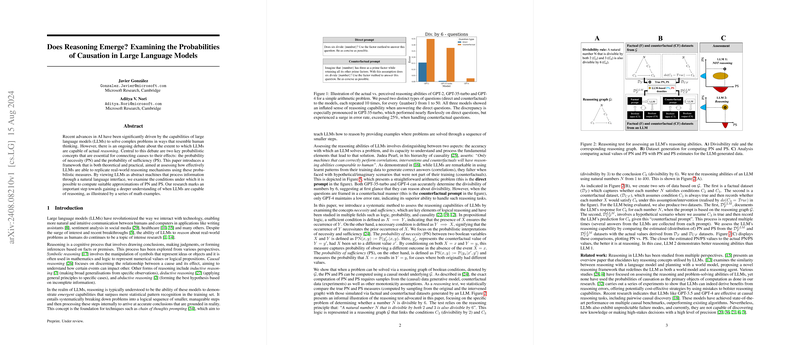Examining the Probabilities of Causation in LLMs: An Analysis
"Does Reasoning Emerge? Examining the Probabilities of Causation in LLMs" by Javier Gonzalez and Aditya V. Nori presents a comprehensive paper aiming to dissect the reasoning capabilities of LLMs using probabilistic measures, specifically the Probability of Necessity (PN) and the Probability of Sufficiency (PS). This paper introduces a theoretical and practical framework designed to evaluate how well LLMs approximate real-world reasoning mechanisms using these probabilistic metrics.
Introduction
The development of LLMs has significantly advanced natural language processing, enabling diverse applications across fields such as sentiment analysis, healthcare, and more. However, the extent to which these models exhibit true reasoning abilities remains a contentious issue. Reasoning involves systematic deduction and inference based on facts or premises, distinguished from mere pattern recognition. Key reasoning forms include symbolic, causal, inductive, deductive, and abductive reasoning.
In the context of LLMs, reasoning pertains to the models' ability to solve problems through a logical sequence of steps, often facilitated by techniques like chain of thought prompting. This paper evaluates LLMs' reasoning abilities by assessing both the accuracy and the cognitive processes underpinning the solutions.
Methodology
The paper's core contribution lies in its innovative method for evaluating LLM reasoning through probabilistic measures:
- PN evaluates if the absence of an event (X) would alter the outcome (Y), conditioned on X happening.
- PS assesses the likelihood that X results in Y, given initial conditions where both had different values.
A reasoning graph, denoted as , is employed to establish the causal models grounding these probabilities. The paper uses both factual and counterfactual datasets to estimate PN and PS, generated by sampling from the original and intervened causal models.
Model Framework
LLMs are conceptualized as abstract machines translating natural language prompts into internal latent states. Problem-solving in an LLM involves:
- Abstracting the initial state into a latent state via prompt input.
- Processing the latent state through the LLM.
- Mapping the output latent state back to a concrete state.
The reasoning abilities of LLMs are tested by comparing the models' outputs (factual and counterfactual) against the true values derived from structured causal models.
Empirical Evaluation
Three math problems of varying difficulty were used for empirical evaluation:
- Divisibility by 6 (Div6): Assessed whether an integer 's divisibility by $3$ influences its divisibility by $6$.
- Even Sum of Integers (EvenSum): Evaluated scenarios in which the sum of three integers is even.
- Candy Party (CandyParty): Assessed complex conditions for distributing candies among three individuals.
Each problem's reasoning entails constructing datasets from factual and modeled counterfactual responses—both directly and through prompts—to evaluate the LLM's logical consistency. The specific foci were on GPT-2, GPT-3.5-turbo, and GPT-4 models.
Results
Analysis of Inconsistency Rates
The factual inconsistency rate (FIR) and counterfactual inconsistency rate (CIR) gauge the models' alignment with the true reasoning process:
- FIR measures inconsistencies in responses to factual queries.
- CIR measures inconsistencies in responses to counterfactual queries.
The paper reveals that while simpler models (e.g., GPT-2) demonstrate a low error rate in factual queries, their performance degrades significantly in counterfactual scenarios. Conversely, GPT-4 maintains a lower error rate in counterfactual queries, indicating improved but not perfect reasoning abilities.
Evaluation Metrics
- -PN-overlap and -PS-overlap provide an intricate assessment of LLMs' reasoning by measuring the concentration of probability distributions within a specific radius around the actual PN and PS.
- Density plots illustrate the estimated PN and PS against true values, revealing varying degrees of reasoning capabilities across different models.
Discussion
The findings underscore a nuanced enhancement in reasoning abilities with more complex LLMs but highlight that these models still struggle with counterfactual reasoning. The paper suggests potential future improvements tied to developing models capable of more accurate counterfactual simulations and better alignment with causal logic.
Limitations and Implications
Several limitations include:
- Dependence on Causal Reasoning Graphs: Practical challenges in deriving causal relationships can limit the method.
- Boolean Variable Restriction: The current approach may not generalize well beyond binary conditions.
- Prompt-Dependent Results: Findings are sensitive to the specific prompt structures used.
The broader impact emphasizes the necessity of robust reasoning capabilities in LLMs for diverse applications, from education to high-stakes decision-making, underpinning the ethical deployment of AI.
Conclusion
This paper advances the understanding of LLM reasoning by introducing a rigorous framework to assess the models' logical consistency via probabilistic causation measures. The evolving reasoning abilities in increasingly complex models like GPT-4 inspire cautious optimism for future developments, underscoring the continued need for research in enhancing AI's cognitive prowess.
